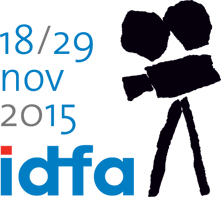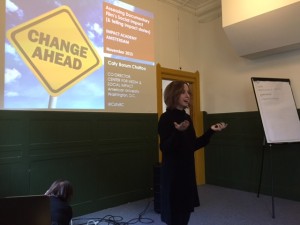 For documentary filmmakers, strategists, funders, broadcasters, buyers – and of course, fans – November means the International Documentary Film Festival Amsterdam (IDFA), the premier international festival celebrating the best of the form from around the world. CMSI leaders hit the ground running in Amsterdam this year, playing key roles as speakers and participants.
For documentary filmmakers, strategists, funders, broadcasters, buyers – and of course, fans – November means the International Documentary Film Festival Amsterdam (IDFA), the premier international festival celebrating the best of the form from around the world. CMSI leaders hit the ground running in Amsterdam this year, playing key roles as speakers and participants.
On the opening day of the festival and forum, CMSI founder and senior research fellow, Pat Aufderheide, moderated a panel titled, “Evaluating Impact: Challenges and Opportunities in Working with Impact Metrics in Documentary,” leading a discussion with an ecosystem of media-impact strategists, broadcasters and fundraisers, including Jessica Clark (Dot Connector Studios), Patricia Finneran (Story Matters), Beadie Finzi (BRITDOC), Klara Grunning-Harris (Swedish Film Institute) and Leevi Kokko (YLE). The panel also featured special guest respondents – Marie Nelson from PBS, Ellen Schneider from Active Voice, and yours truly from CMSI – who weighed in with the panel and audience about key topics. The major thru-line was a rich discussion about how evaluating a film’s reach and social impact can be used to the filmmaker’s advantage – and used to lift up the documentary art form and encourage more investment in the work.
Pat began by showcasing slides to “dispel some common myths,” including:
- Myth 1: Impact measurement is not new. Truth: In fact, media effects research is a well-established area that’s been applied to media storytelling for decades.
- Myth 2: Impact is for social issue films alone. Truth: But entertainment storytelling has profound social impact, as exemplified in many examples over the years, including the role of TV portrayals of gay and lesbian characters.
- Myth 3: Funders slight documentary work that can’t show impact. Truth: There’s no evidence this is true, and in fact, today’s documentaries exist in a world with many different types of funding – including crowd-sourcing and more.
- Myth 4: Impact reduces art to numbers. Trutth: In fact, goals and strategies in the nonprofit and arts arena is not new, and research used to showcase impact is rich with excellent qualitative data that is not about numbers. Pat called on the audience to look at my CMSI white paper, “Assessing the Social Impact of Issues-Focused Documentaries,” along with the many BRITDOC impact case studies, for examples of rich research approaches used to spotlight social impact.
- Myth 5: Impact metrics are an “extra.” Truth: From the panelists’ perspective, research allows helpful feedback to filmmakers’ work.

Pat Aufderheide moderating “Evaluating Impact: Challenges and Opportunities in Working with Impact Metrics in Documentary,”
As Beadie Finzi sees it, this is an exciting moment in the innovation of documentary storytelling and a break from old ways of doing business. “Our beautiful and precious field is still in the grips of this problem that box office and TV ratings are worshipped as gods. This is really unfortunate and it absolutely impacts what projects are even made. The idea that we can strive to understand the other ways our work can have value in the world. I am not only interested about evaluation, but I’m excited about it,” she said.
The other panelists emphasized their perspectives on impact assessment. They all encourage filmmakers to add the work to their budgets, and they reinforced the great benefit of having stories to share about how the stories have value beyond audience reach. According to PBS’ Marie Wilson, “The broadcaster in me wants us to use the tools available to bring more of this content to our air. We need more filmmakers pounding the pavement about how this work has meaning and reach, because these are not ratings machines. If we are successful is expanding our ability to do this work in a rich way, we have a great argument we can make about why these films should continue to be made.”
The next day, I was invited – along with Larry Kirkman, CMSI senior research fellow and strategic advisor, and Pat – to participate in the first-ever Global Impact Producers Assembly hosted by BRITDOC. The all-day gathering was an invitation-only convening featuring documentary filmmakers and social-impact strategists and researchers from 18 countries around the world. The gathering served as continued discussion about an evolving profession created in the efforts to research and create social change through documentary storytelling – the “impact producer.” Since an initial BRITDOC gathering in 2011, the rise and formalization of this new professional – a combination strategic communication professional, grassroots mobilizer, public affairs strategist and distribution expert, along with some research chops – has picked up steam both in the U.S. and around the world. With the 90 or so professionals in attendance, the mix of featured projects and people – including teams from the Academy-Award-nominated Virunga to Bully – showcased the richness and evolution of the work over a fast-moving four years. Major themes focused on best practices and innovation, including an increasing need to complete research and learn from global colleagues.
Wrapping up the CMSI week in Amsterdam, I was invited to give a talk at the inaugural gathering of the Netherlands Impact Academy, a group of filmmakers and social-change strategists who are creating a Dutch model for designing, campaigning and evaluating the social impact of documentaries. The audience included leaders and participants of the Netherlands Impact Academy, along with leaders and members of Movies That Matter, a human-rights festival initiative of Amnesty International and one of the founding members of the Human Rights Film Network, a network of 34 festivals worldwide that highlights social justice through film. My talk focused on a strategic examination of social impact through documentary storytelling, some of the foundational ideas and history of storytelling for social change, and a workshop approach to designing research to assess social impact. It’s pretty incredible to meet new global colleagues working on the same pursuit of social change through media around the world, and hopefully the discussion will lead to future international collaborations.
I was also honored to serve on the jury for the 2015 BRITDOC International Documentary Impact Awards, along with the leaders of the Sundance Documentary Institute, Ford Foundation’s JustFilms, BRITDOC, Fledgling Fund, Compton Foundation, Chicken & Egg Pictures, Participant Media and Media Impact Funders. Our group gathered in Amsterdam to jury the awards, which will be announced in January 2016.
Inspiring and motivating, and we’re ready for more, more, more in 2016 and beyond.

